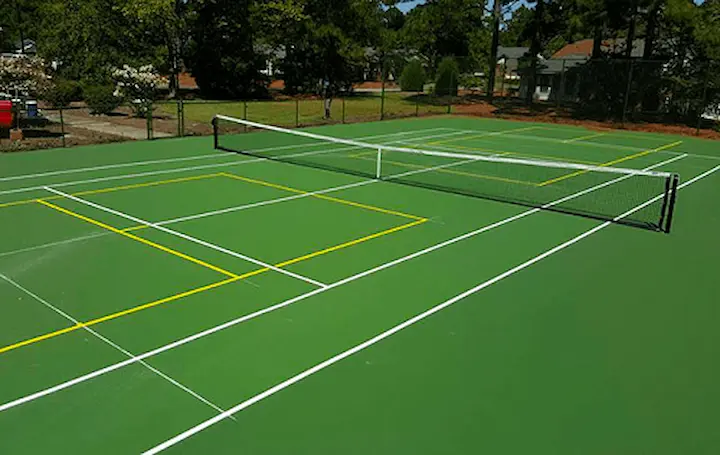Trick Consider the Building of Pickleball Judiciaries: From Site Selection to Last Surfaces
The building and construction of pickleball courts incorporates a variety of important variables, starting with the selection of a suitable site that stabilizes access with environmental considerations. Important aspects such as court measurements, surface products, and water drainage systems significantly impact not only the quality of play but also the durability of the center.
Website Choice Requirements
When beginning on the building and construction of pickleball courts, it is important to pin down the website option standards that will certainly make certain optimum playability and access. The area has to be conveniently obtainable for players, preferably positioned near suburbs or recreation center, to urge involvement.
Additionally, the terrain ought to be level and steady, as uneven ground can lead to safety and security threats and impact gameplay. Sufficient drainage is additionally essential; choosing a site with good water drainage will certainly help keep court problems during adverse climate.
An additional essential consideration is the availability of energies. Access to electricity and water is essential for illumination and maintenance objectives. Additionally, proximity to car parking centers is necessary, helping with easy gain access to for players and viewers alike.
Environmental factors can not be forgotten; natural color from trees can enhance gamer comfort, while direct exposure to prevailing winds might interrupt play. Zoning regulations and neighborhood assistance should be thought about to guarantee that the task aligns with regional standards and receives the backing it requires for effective implementation. By thoroughly reviewing these criteria, stakeholders can produce a welcoming and useful environment for pickleball lovers.
Court Capacities and Format
To ensure ideal gameplay and adherence to laws, the measurements and design of pickleball courts have to be carefully defined. A basic pickleball court gauges 20 feet in width and 44 feet in length for both singles and doubles play. The suggested design consists of a non-volley area, generally referred to as the "kitchen area," expanding 7 feet from the web on either side. This location is crucial, as it influences player positioning and shot selection - Illinois and midwest.
The net height is set at 36 inches at the sidelines and 34 inches at the center, creating a slight dip that influences round trajectory. Court markings are just as vital; lines must be 2 inches large and distinctive in shade to guarantee exposure.
Additionally, a buffer area bordering the court is a good idea, usually prolonging 5 to 10 feet beyond the sidelines and baselines to suit gamers' motions and enhance safety and security. Correct design and dimensions not just make certain conformity with official regulations yet likewise enhance the total having fun experience, fitting both recreational and affordable play. Careful preparation in these locations is critical to the effective building of pickleball courts.
Surface Product Options
Choosing the right surface material for pickleball courts is essential for ensuring ideal player efficiency and safety and security. The selection of surface can dramatically impact gameplay, including sphere bounce, traction, and gamer convenience.
There are a number of options offered, each with its distinct attributes. Asphalt is a preferred choice as a result of its toughness and low upkeep requirements. It supplies a strong playing surface area that can endure various weather however might require regular resurfacing.
Concrete is another extensively utilized material, providing superb longevity and a smooth surface. It permits for consistent sphere bounce yet can be hard on players' joints, making it much less preferable for long-term play without appropriate padding.
For those looking for enhanced comfort and shock absorption, supported acrylic surface areas provide a feasible choice. These surface areas integrate a base layer with an acrylic overcoat, providing improved grip and a softer feeling, which is beneficial for lowering the threat of injuries.
Lastly, synthetic grass is obtaining grip, particularly for multi-purpose facilities. Its convenience and lower maintenance needs make it an appealing choice, though it might not give the very same company website ball response as typical hard courts. Careful consideration of these options will guarantee an optimal playing environment.
Drainage and Lighting Factors To Consider
Correct drain and effective lighting are necessary components in the building and construction of pickleball courts, substantially influencing both playability and go to my blog safety. Appropriate drainage systems protect against water build-up, which can lead to slippery surface areas and damages to the court structure.
Lights is just as essential, specifically for courts planned for evening usage. The positioning of illumination fixtures need to be tactically planned to eliminate shadows and offer even circulation of light throughout the court.

Last Coatings and Upkeep
After resolving drain and lighting considerations, focus transforms to the final coatings and recurring upkeep of pickleball courts. Usual choices include acrylic coverings and specialized sporting activities surface areas that supply optimal traction and cushioning.

Seasonal maintenance might consist of resurfacing every few years, depending upon use and environmental variables. Correctly preserving nets, court lines, and surrounding locations is similarly important to supply a secure and pleasurable having fun experience. By buying quality surfaces and sticking to a structured maintenance routine, center owners can ensure their pickleball courts stay in superb condition for years to find.
Verdict
In additional reading conclusion, the successful building of pickleball courts depends upon precise interest to numerous key elements. Site choice must focus on accessibility and terrain stability, while court dimensions and design need to stick to optimum standards for gameplay. The choice of surface material significantly influences player safety and performance. Furthermore, efficient drain and appropriate illumination add to court durability and exposure. Finally, high quality finishes and a robust upkeep timetable are essential for maintaining the court's problem, boosting the general experience for players and spectators alike.